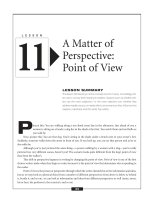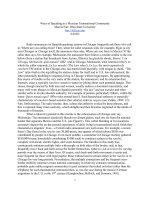Ways matter changes
Bạn đang xem bản rút gọn của tài liệu. Xem và tải ngay bản đầy đủ của tài liệu tại đây (2.21 MB, 10 trang )
Genre
Nonfiction
Comprehension Skill
Cause and Effect
Text Features
• Captions
• Labels
• Glossary
Science Content
Changes in Matter
Scott Foresman Science 3.11
ISBN 0-328-13839-8
ì<(sk$m)=bdidjf< +^-Ä-U-Ä-U
Vocabulary
chemical change
mixture
physical change
solution
states of matter
What did you learn?
1. What are the three states of matter?
2. What are some examples of physical
changes that matter can go through?
3. How do you create a mixture?
Picture Credits
Every effort has been made to secure permission and provide appropriate credit for photographic material.
The publisher deeply regrets any omission and pledges to correct errors called to its attention in subsequent editions.
Photo locators denoted as follows: Top (T), Center (C), Bottom (B), Left (L), Right (R), Background (Bkgd).
4 (BR) ©Comstock Inc.; 12 Getty Images; 14 Paula Solloway/Alamy Images.
Unless otherwise acknowledged, all photographs are the copyright © of Dorling Kindersley, a division of Pearson.
ISBN: 0-328-13839-8
Copyright © Pearson Education, Inc. All Rights Reserved. Printed in the United States of America.
This publication is protected by Copyright, and permission should be obtained from the publisher prior to any
prohibited reproduction, storage in a retrieval system, or transmission in any form by any means, electronic,
mechanical, photocopying, recording, or likewise. For information regarding permission(s), write to
Permissions Department, Scott Foresman, 1900 East Lake Avenue, Glenview, Illinois 60025.
3 4 5 6 7 8 9 10 V010 13 12 11 10 09 08 07 06 05
4.
In this book you
by Thea
have
readFeldman
about how burning matter
affects its state. Write to explain
what happens to a candle when it is
burned, using details from the book.
5.
Cause and Effect What is the
effect of mixing hot chocolate powder
with hot water?
Physical Changes
Of Matter
The physical properties of matter include
size, shape, color, position, and mass. Physical
properties can usually be changed without
changing the matter. A physical change takes
place when matter changes the way it looks
without becoming a new kind of matter.
Suppose you have several pieces of wood. If
you take that wood and build a birdhouse with it,
you have created a new shape. What happens if
you paint the birdhouse green? You have changed
the color. When you put the birdhouse outside,
you have changed its position.
A lot of physical changes
have been made to the pieces
of wood. But guess what?
You have not changed the
original matter of the wood.
It is still made of the same
solid matter. It has just been
rearranged and painted, and
it had its position changed.
The finished, painted
birdhouse outside
Pieces of
wood
2
3
Different Forms
Of Matter
There are three different forms or states of
matter. Something can be a solid, a liquid, or a gas.
A rock, a piece of wood, a drinking glass, and
a kite are examples of solids. Every solid has its
own mass, shape, size, and color.
Milk, juice, water, soup, and oil are liquids.
Liquids also have mass, size, and color. They take
the shape of the container they are held in.
4
Most gases are invisible. You may not even
realize they are there. Gases also have mass. Like
liquids, gases have no shape of their own, but
they may have an odor.
Gases are all around you. The air is filled with
gases, such as oxygen, which is an odorless and
colorless gas.
5
Sometimes a physical change can cause the
state of matter to change. But even a change in
the state of matter does not change the actual
matter.
When water freezes, it changes from a liquid
state to a solid state. However, it is still water,
just a different form of it.
A liquid, such as juice,
can change into a
frozen state. But it is
still made up of the
same matter.
6
Solids can change
into liquids, but they
are still the same
kind of matter.
Matter does not change when a solid turns
into a liquid either. Think about a solid block
of chocolate. If you heat the chocolate, it will
begin to melt into a liquid. But the particles in
the chocolate have not changed. The chocolate
has not turned into something else. It is still
chocolate in either form.
If you let the melted chocolate cool, it will
return to its original solid state. It will most likely
be a different shape, so it will have undergone
another physical change. But it should still taste
like chocolate.
7
Combining Matter
Another way to change matter is to combine
it with other matter. A mixture is two or more
kinds of matter put together. The kinds of
matter do not need to be put together in equal
parts. A container full of nuts and bolts is a
mixture. It is easy to pick out and separate the
nuts and bolts from this mixture.
The most important thing about a mixture
is that the kinds of matter do not change into
other substances when mixed together. A
mixture of pencils, markers, and crayons can
easily be separated into three piles. These writing
tools do not change into something else when
they are mixed.
8
9
Have you ever had a mug of hot chocolate
on a cold day? Do you know how it is made?
Put a spoonful of instant hot chocolate powder
in a mug. Then have an adult add some boiling
water. What happens? The hot chocolate
dissolves in the water. The water becomes a
different color. You cannot see any instant hot
chocolate. What you have made is a solution.
Instant hot
chocolate
A solution is a mixture in which one or
more substances dissolve into another. The hot
chocolate is still in the mug. If all the liquid
evaporated, you would be left with hot chocolate
powder. Just like a mixture, it is usually possible
to separate all the substances from a solution.
Even though substances have combined, they
have not really changed. Combining these
substances is another example of a physical
change.
10
11
Chemical Changes
To Matter
Sometimes changes produce a new
kind of matter. What could cause this?
You know a physical change does not
create new matter. During a chemical
change, one kind of matter changes
into a different kind of matter. Once
a material has undergone a chemical
change, it usually cannot be changed
back to its original form.
Burning matter is one example
of a chemical change. Think about
a candle. First the wax melts. It
changes from a solid to a liquid.
This is a physical change. Then it
burns. This is a chemical change.
The candle has changed into gases.
It cannot change back into the solid
candle again. It is no longer the
same substance. It has changed
chemically.
12
Making cookies
Baking is an easy way to see and understand
how chemical changes affect matter.
If you follow a cookie recipe correctly, you
will mix together flour, milk, eggs, sugar, and
other ingredients to form a batter. When you
bake the batter in an oven,
a chemical change takes
place. The batter turns
into cookies. You cannot
separate the ingredients
from the cookies.
Baked cookies
13
Chemical changes to matter can make your life
better. Useful chemical changes are created
by burning certain kinds of matter. Burning a
candle gives you light. Burning heating oil warms
your house. Burning gasoline allows your family
car to run.
Baking cookies gives you something to eat.
The cookies and other food you eat go through
chemical changes in your body.
Your body breaks food down chemically
into nutrients and other things you need to be
healthy. Runners often eat a big meal of pasta
the night before a big race. They know that
food changes chemically in their bodies. Food
such as pasta changes chemically into a source
of energy that can help a runner on race day.
Foods that are
sources of energy
can help a runner
on race day.
14
15
What did you learn?
Vocabulary
Glossary
chemical change
mixture change
chemical
physical change
solution
states of matter
when one kind of matter
changes into another kind
of matter
mixture
a combination of two
or more kinds of matter
that keep their properties
physical change
when the size, shape, color,
weight, or position of
matter is changed
solution
a mixture in which one or
more substances dissolves
into another
Picture Credits
Every effort has been made to secure permission and provide appropriate credit for photographic material.
The publisher deeply regrets any omission and pledges to correct errors called to its attention in subsequent editions.
states of matter
the different forms that
matter can take: liquid,
Photo locators denoted as follows: Top (T), Center (C), Bottom (B), Left (L), Right (R), Background (Bkgd).
4 (BR) ©Comstock Inc.; 12 Getty Images; 14 Paula Solloway/Alamy
Images.
solid, or
gas
Unless otherwise acknowledged, all photographs are the copyright © of Dorling Kindersley, a division of Pearson.
ISBN: 0-328-13839-8
Copyright © Pearson Education, Inc. All Rights Reserved. Printed in the United States of America.
This publication is protected by Copyright, and permission should be obtained from the publisher prior to any
prohibited reproduction, storage in a retrieval system, or transmission in any form by any means, electronic,
mechanical, photocopying, recording, or likewise. For information regarding permission(s), write to
Permissions Department, Scott Foresman, 1900 East Lake Avenue, Glenview, Illinois 60025.
3 4 5 6 7 8 9 10 V010 13 12 11 10 09 08 07 06 05
16
1. What are the three states of matter?
2. What are some examples of physical
changes that matter can go through?
3. How do you create a mixture?
4.
In this book you
have read about how burning matter
affects its state. Write to explain
what happens to a candle when it is
burned, using details from the book.
5.
Cause and Effect What is the
effect of mixing hot chocolate powder
with hot water?









